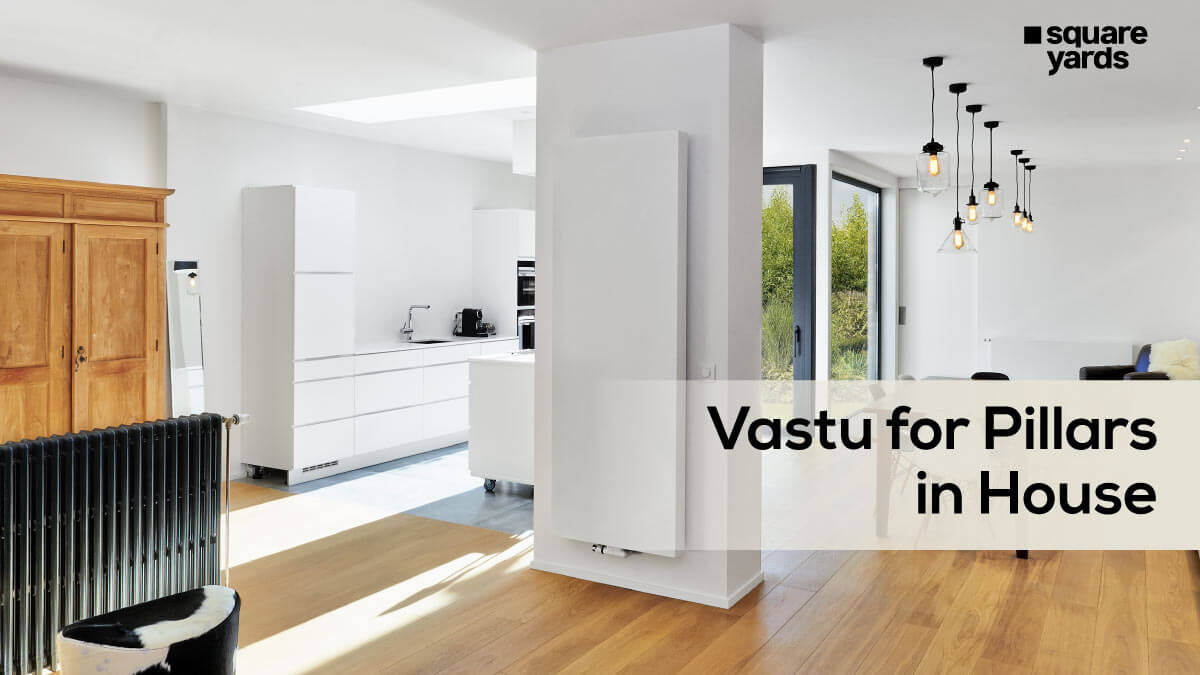A building's pillars and beams provide it with the strength it needs to survive all the challenges of the changing climate over time and stand tall for numerous decades. However, if the pillars are positioned incorrectly, they may negatively impact the occupants of a home. A poorly constructed pillar may seriously impede the development of your family members over the long term and may also lead to conflicts within the family. As a result, Vastu for pillars in a house must be strictly adhered to achieve success.
This guide provides its readers with helpful placements, dos and don'ts of the Vastu for a pillar in a house.
Table of contents
Placements
When building or remodelling a house, Vastu plays an important role. Doing things as per Vastu brings happiness and prosperity to a home and its residency. Pillars are, nevertheless, the backbone of a house. Pillars should have the following placements to ensure maximum benefits to house residents.
- Avoid pillars in Brahmasthan or the centre of the house. If the need arises, fix a copper pyramid or swastika to curb the negativity and restore balance.
- Around the porch, pillars without arches are OK as long as they are apart from the main house. The portico's roof shouldn't touch the compound wall and should be lower than the house's roof line. Vastu advises against building a pillar to support the porch's roof in the northeast. Use a plank roof instead, but ensure it is lower than the house roof.
- Avoid the presence of house pillars in the sleeping space because they might disrupt restful sleep and increase stress. A Vastu fault is deemed to be seated even beneath an exposed beam. Tie two bamboo flutes to the beam or pillar with a red ribbon or fabric to lessen the negative effects.
- A pillar shouldn't obstruct the main gate, the entrance, or the main entrance itself because this is where the beneficial energies of prosperity and good health enter a home. Hang a painting of grassland or a road, and paint the pillar in a colour that evokes a vast, open space.
Do's and Don'ts
The practice of Vastu Shastra, an architectural science, dates back to the Vedic eras in India. Every beam-column Vastu in Indian architecture is carefully thought about when creating a workspace or a home. From the layout to the number of columns in the building to the ventilation arrangement - everything is determined by Vastu. So, we have compiled a few do’s and don'ts on Vastu for a pillar in a house.
Do’s
Cover Sharp Pillars
Ideally, hide the sharp end of any pillars in your home with mirrors or plants to ensure the mirror or plant absorbs any bad energy. You must remember if you hang a mirror as per vastu, it shouldn't reflect an entrance or a bathroom.
Place Vastu Pyramids
Pyramids, according to Vastu, must be placed at your home's key locations where an overhead beam is present. It is required to remove any Vastu Dosha that may be present in your home.
Hang Flutes
Hang two flutes draped in red cloth within your home to offset the negative effects of visible pillars and beams.
The Number of Pillars
Columns and pillars are constructed to distribute the structure's load evenly. They may negatively impact the residents if built in the wrong location. According to Vastu Shastra, it can also affect how a family expands. According to Vastu, an even number of house pillars promotes harmony and wealth. So, when building a house, it's vital to examine the number of pillars or columns, according to Vastu.
Don'ts
No Pillars at the Entrance
A pillar shouldn't obstruct the main gate, the entrance, or the main entrance itself because this is where the beneficial energies of good health and prosperity enter a home. Vastu advises changing the main entrance to a more favourable direction. You may also hang a painting of grassland or road and paint the pillar in a colour that evokes a vast and open space.
No Pillars in the Brahmasthan
According to Vastu Shastra, the centre of the house, or Brahmasthan, is where all directions converge. It is a powerful and holy part of the house. There should ideally be no structures in this area to ensure the house's flourishing. This area should be clear of barriers to draw harmony and happiness because it is the energy distributed throughout the house. Therefore, the residents may experience challenges and hardships as a result of the pillar in the Brahmasthan.
Avoid Gaps Between Multiple Pillars
According to Vastu, wealth flees from a house structured by numerous pillars with huge gaps between them. For riches and luck, it is preferable to close these gaps following Vastu principles. Make a wall or cover the spaces between the pillars with bookcases and storage cabinets to block off bad energy.
Avoid Pillars in the Living Room
The living room should ideally not have any house pillars. According to Vastu, it is preferable to partition a room from a pillar and create a separate eating space, home office, or TV room if it contains a pillar. Place a peacock feather on the pillar to increase luck and lessen Vastu dosha.
Pillars Should Not Have Protruding Edges
In your home, you must check there are no sharp edges. It severely disrupts the natural flow of positive energy in your home. According to Vastu Shastra, correct the projecting edge of pillars immediately.
Make Your home Vastu Compliant - with Top Vastu Consultant
Conclusion
Vastu for pillars in a house ensures the safety and security of house residents. Follow our guide and plan the placement of the pillars accordingly for them to absorb the negative energy and flourish your house with health, wealth and happiness. Let your home emit soothing green vibes.
Frequently Asked Questions (FAQs)
How many pillars should a house have?
The number of pillars required in a house depends upon the size of your home. For instance, a house expanding to 1200 square feet requires at least 16 pillars. It ensures the stability of the house.
Can we have a pillar in the northeast corner?
Yes, a house can have pillars in the northeast corner. However, the shape of the pillars should not be octagonal, circular, polygonal, hexagonal, or multi-angular.
Is a pillar required for house construction?
The pillars are a vital part of the house construction process. The pillars promise stability, and strength and are incorporated into the design plan as per the load it needs to carry.
Can we remove the pillars from the house?
Once the house is built, with the support of the pillars, it is not advisable to remove them. Pillars support the heavy weight of the structure, and altering them could have significant side effects. Therefore, consult a structural engineer before making any decision.
How many pillars are enough per Vastu?
As per Vastu, the count of the pillars should be even in number. If it is odd in number, add one more. It ensures a house full of peace and prosperity.
Can I build 3 floors without pillars?
Yes, you can build three floors without pillars. You can use beams instead of pillars and increase the wall’s width. Hence, ensuring better support.






